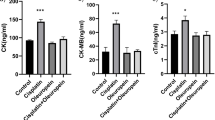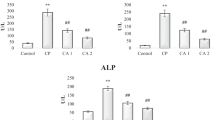Abstract
The prevalence of cancer, in the world is increasing steadily. Despite intense research efforts, no approved therapy is yet available. Cisplatin is a chemotherapeutic drug but induces acute tissue injury. Oleuropein (OLE) is a major phenolic compound and used as a possible natural antioxidant, antimicrobial, and anticancer agent. We hypothesized that antioxidant activity of OLE may decrease cisplatin-induced oxidative stress and prevent to the development of chemotherapeutic complications including abnormality in hematological condition. Male Sprague Dawley rats were used in the experiments. Rats were randomly assigned to one of eight groups: control group; group treated with i.p. injection in a single dose of 7 mg/kg/day cisplatin; groups treated with 50, 100 and 200 mg/kg/day OLE (i.p.); and groups treated with OLE for 3 days starting at 24 h following cisplatin injection. First, hematological assessment was appreciated between control and experimental groups. Second, total oxidative stress (TOS) and total antioxidant capacity (TAC) levels of blood were measured by biochemical studies. In addition to this, oxidative DNA damage was determined by measuring as increases in 8-hydroxy-deoxyguanosine (8-OH-dG) adducts. The treatment with cisplatin elevated the TOS and 8-OH-dG levels that were then reversed by OLE. Reductions in antioxidant capacity with respect to corresponding controls were also restored by OLE treatment. These findings suggest that the OLE treatment against cisplatin-induced toxicity improves the function of blood cells and helps them to survive in the belligerent environment created by free radicals.
Similar content being viewed by others
References
Li WB, Li Y, Yu C, He YM (2015) Reversal of multidrug resistance by the Chinese medicine Yiqi Jianpi Huaji decoction and the mechanism of action in human gastric cancer SGC7901/VCR Cells. Evid Based Complement Altern Med. doi:10.1155/2015/390812
Livingston RB (1989) Cisplatin in the treatment of solid tumors: effect of dose and schedule. J Natl Cancer Inst 81:724–725
Rasoulian B, Kaeidi A, Pourkhodadad S, Dezfoulian O, Rezaei M, Wahhabaghai H, Alirezaei M (2014) Effects of pretreatment with single-dose or intermittent oxygen on Cisplatin-induced nephrotoxicity in rats. Nephro Urol Mon. doi:10.5812/numonthly.19680
Cetin D, Hacımuftuoglu A, Tatar A, Turkez H, Togar B (2015) The in vitro protective effect of salicylic acid against paclitaxel and cisplatin-induced neurotoxicity. Cytotechnology. doi:10.1007/s10616-015-9896-3
Wheeler HE, Wing C, Delaney SM, Komatsu M, Dolan ME (2015) Modeling chemotherapeutic neurotoxicity with human induced pluripotent stem cell-derived neuronal cells. PLoS ONE. doi:10.1371/journal.pone.0118020
Kim HJ, Park DJ, Kim JH, Jeong EY, Jung MH, Kim TH, Yang JI, Lee GW, Chung HJ, Chang SH (2015) Glutamine protects against cisplatin-induced nephrotoxicity by decreasing cisplatin accumulation. J Pharmacol Sci 127:117–126
Osman AM, Telity SA, Damanhouri ZA, Al-Harthy SE, Al-Kreathy HM, Ramadan WS, Elshal MF, Khan LM, Kamel F (2015) Chemosensitizing and nephroprotective effect of resveratrol in cisplatin–treated animals. Cancer Cell Int. doi:10.1186/s12935-014-0152-2
Waseem M, Bhardwaj M, Tabassum H, Raisuddin S, Parvez S (2015) Cisplatin hepatotoxicity mediated by mitochondrial stress. Drug Chem Toxicol 38:452–459
Bhuvarahamurthy V, Balasubramanian N, Govindasamy S (1996) Effect of radiotherapy and chemoradiotherapy on circulating antioxidant system of human uterine cervical carcinoma. Mol Cell Biochem 158:17–23
Takeuchi T, Nakajima M, Morimoto K (1996) Relationship between the intracellular reactive oxygen species and the induction of oxidative DNA damage in human neutrophil-like cells. Carcinogenesis 17:1543–1548
Satoh M, Kashihara N, Fujimoto S, Horike H, Tokura T, Namikoshi T, Sasaki T, Makino H (2003) A novel free radical scavenger, edarabone, protects against cisplatin-induced acute renal damage in vitro and in vivo. J Pharmacol Exp Ther 305:1183–1190
Saleh S, El-Demerdash E (2005) Protective effects of l-arginine against cisplatin-induced renal oxidative stress and toxicity: role of nitric oxide. Basic Clin Pharmacol Toxicol 97:91–97
Appenroth D, Frob S, Kersten L, Splinter FK, Winnefeld K (1997) Protective effects of vitamin E and C on cisplatin nephrotoxicity in developing rats. Arch Toxicol 71:677–683
Sener G, Satiroglu H, Kabasakal L, Arbak S, Oner S, Ercan F, Keyer-Uysa M (2000) The protective effect of melatonin on cisplatin nephrotoxicity. Fundam Clin Pharmacol 14:553–560
Nisar S, Feinfeld DA (2002) N-acetylcysteine as salvage therapy in cisplatin nephrotoxicity. Ren Fail 24:529–533
Ali BH, Al Moundhri MS (2006) Agents ameliorating or augmenting the nephrotoxicity of cisplatin and other platinum compounds: a review of some recent research. Food Chem Toxicol 44:1173–1183
Karimi G, Aghasizadeh M, Razavi M, Taghiabadi E (2011) Protective effects of aqueous and ethanolic extracts of Nigella sativa L. and Portulaca oleracea L. on free radical induced hemolysis of RBCs. Daru 19:295–300
Obied HK, Karuso P, Prenzler PD, Robards K (2007) Novel secoiridoids with antioxidant activity from Australian olive mill waste. J Agric Food Chem 55:2848–2853
Bulotta S, Celano M, Lepore SM, Montalcini T, Pujia A, Russo D (2014) Beneficial effects of the olive oil phenolic components oleuropein and hydroxytyrosol: focus on protection against cardiovascular and metabolic diseases. J Transl Med 12:219–225
Casamenti F, Grossi C, Rigacci S, Pantano D, Luccarini I, Stefani M (2015) Oleuropein aglycone: a possible drug against degenerative conditions. In vivo evidence of its effectiveness against Alzheimer’s disease. J Alzheimer’s Dis 45:679–688
Al-Azzawie HF, Alhamdani MSS (2006) Hypoglycemic and antioxidant effect of oleuropein in alloxan-diabetic rabbits. Life Sci 78:1371–1377
Omagari K, Kato S, Tsuneyama K, Hatta H, Sato M, Hamasaki M, Sadakane Y, Tashiro T, Fukuhata M, Miyata Y, Tamaru S, Tanaka K, Mune M (2010) Olive leaf extract prevents spontaneous occurrence of non-alcoholic steatohepatitis in SHR/NDmcr-cp rats. Pathology 42:66–72
Zukovec TD, Zivkovic L, Cabarkapa A, Djelic N, Bajic V, Dekanski D (2015) Dry olive leaf extract counteracts l-thyroxine-induced genotoxicity in human peripheral blood leukocytes in vitro. Oxid Med Cell Longev. doi:10.1155/2015/762192
Barbaro B, Toietta G, Maggio R, Arciello M, Tarocchi M, Galli A (2014) Effects of the olive-derived polyphenol oleuropein on human health. Int J Mol Sci 15:18508–18524
National Research Council (1996) Guide for the care and use of laboratory animals. National Academy Press, Washington
Erel O (2004) A novel automated method to measure total anti-oxidant response against potential free radical reactions. Clin Biochem 37:112–119
Erel O (2005) A novel automated colorimetric method for measur-ing total oxidant status. Clin Biochem 38:1103–1111
Nie JH, Chen ZH, Liu X, Wu YW, Li JX, Cao Y, Hei TK, Tong J (2012) Oxidative damage in various tissues of rats exposed to radon. J Toxicol Environ Health 75:694–699
Chan R, Mascarenhas L, Boles RG, Kerkar N, Genyk Y, Venkatramani R (2015) Hepatoblastoma in a patient with methylmalonic aciduria. Am J Med Genet A 167:635–638
Gao LP, Li Z, Guo ZY, Zhao YM (2013) The effects of vitamin C on DDP-induced anemia in rats. Toxicol Mech Methods 23:383–388
Ghosh S, Bandyopadhyay S, Bhattacharya DK, Mandal C (2005) Altered erythrocyte membrane characteristics during anemia in childhood acute lymphoblastic leukemia. Ann Hematol 84:76–84
Niforou K, Cheimonidou C, Trougakos IP (2014) Molecular chaperones and proteostasis regulation during redox imbalance. Redox Biol 2:323–332
Baliga R, Zhang Z, Baliga M, Ueda N, Shah SV (1998) In vitro and in vivo evidence suggesting a role for iron in cisplatin-induced nephrotoxicity. Kidney Int 53:394–401
Onat H, Inanc SE, Dalay N, Karaloglu D, Erturk N, Yasasever V (1993) Effect of cisplatin on erythropoietin and iron changes. Eur J Cancer 29:777–781
Cazzola M (2000) Mechanisms of anaemia in patients with malignancy: implications for the clinical use of recombinant human erythropoietin. Med Oncol 17:11–16
Bosing B, Tunsmeyer J, Mischke R, Beyerbach M, Kastner SB (2012) Clinical usability and practicability of Alfaxalone for short-term anaesthesia in the cat after premedication with Buprenorphine. Tierarztl Prax Ausg K Kleintiere Heimtiere 40:17–25
Harris AG, Sinitsina I, Messmer K (2002) Validation of OPS imaging for microvascular measurements during isovolumic hemodilution and low hematocrits. Am J Physiol Heart Circ Physiol 282:1502–1509
Tedesco I, Russo M, Russo P, Iacomino G, Russo GL, Carraturo A, Faruolo C, Moio L, Palumbo R (2000) Antioxidant effect of red wine polyphenols on red blood cells. J Nutr Biochem 11:114–119
Lopez-Revuelta A, Sanchez-Gallego JI, Hernandez A, Sanchez-Yague J, Llanillo M (2006) Membrane cholesterol contents influence the protective effects of quercetin and rutin in erythrocytes damaged by oxidative stress. Chem Biol Interact 161:79–91
Li Y, Nishimura T, Teruya K, Maki T, Komatsu T, Hamasaki T, Kashiwagi T, Kabayama S, Shim SY, Katakura Y, Osada K, Kawahara T, Otsubo K, Morisawa S, Ishii Y, Gadek Z, Shirahata S (2002) Protective mechanism of reduced water against alloxan-induced pancreatic beta-cell damage: scavenging effect against reactive oxygen species. Cytotechnology 40:139–149
Moghadam GT, Hosseini-Zijoud SM, Shayesteh TH, Ghasemi H, Ranjbar A (2014) Attenuation of cisplathin-induced toxic oxidative stress by propofol. Anesth Pain Med 4:14–21
Manna C, Galletti P, Cucciolla V, Moltedo O, Leone A, Zappia V (1997) The protective effect of the olive oil polyphenol (3,4-dihydroxyphenyl)-ethanol counteracts reactive oxygen metabolite-induced cytotoxicity in Caco-2 cells. J Nutr Biochem 127:286–292
Manna C, Galletti P, Cucciolla V, Montedoro G, Zappia V (1999) Olive oil hydroxytyrosol protects human erythrocytes against oxidative damages. J Nutr Biochem 10:159–165
Hashimoto T, Ibi M, Matsuno K, Nakashima S, Tanigawa T, Yoshikawa T, Yabe-Nishimura C (2004) An endogenous metabolite of dopamine, 3,4-dihydroxyphenylethanol, acts as a unique cytoprotective agent against oxidative stress-induced injury. Free Radic Biol Med 36:555–564
Alirezaei M, Dezfoulian O, Neamati S, Rashidipour M, Tanideh N, Kheradmand A (2012) Oleuropein prevents ethanol-induced gastric ulcers via elevation of antioxidant enzyme activities in rats. J Physiol Biochem 68:583–592
Ready NE, Pang HH, Gu L, Otterson GA, Thomas SP, Miller AA, Baggstrom M, Masters GA, Graziano SL, Crawford J, Bogart J, Vokes EE (2015) Chemotherapy with or without maintenance sunitinib for untreated extensive-stage small-cell lung cancer: a randomized, double-blind, placebo-controlled phase II study-CALGB 30504 (Alliance). J Clin Oncol. doi:10.1200/JCO.2014.57.3105
Fabiani R, Rosignoli P, De Bartolomeo A, Fuccelli R, Servili M, Montedoro GF, Morozzi G (2008) Oxidative DNA damage is prevented by extracts of olive oil, hydroxytyrosol, and other olive phenolic compounds in human blood mononuclear cells and HL60 cells. J Nutr 138:1411–1416
De la Puerta R, Ruiz-Gutierrez V, Hoult JR (1999) Inhibition of leukocyte 5-lipoxygenase by phenolics from virgin olive oil. Biochem Pharmacol 57:445–449
Zbidi H, Salido S, Altarejos J, Perez-Bonilla M, Bartegi A, Rosado JA, Salido GM (2009) Olive tree wood phenolic compounds with human platelet antiaggregant properties. Blood Cells Mol Dis 42:279–285
Hu Z, Zeng Q, Zhang B, Liu H, Wang W (2014) Promotion of p53 expression and reactive oxidative stress production is involved in zerumbone-induced cisplatin sensitization of non-small cell lung cancer cells. Biochimie 107:257–262
Rybak LP, Husain K, Morris C, Whitworth C, Somani S (2000) Effect of protective agents against cisplatin ototoxicity. Am J Otol 21:513–520
Wu Q, Ni X (2015) ROS-mediated DNA methylation pattern alterations in carcinogenesis. Curr Drug Targets 16:13–19
Acknowledgments
This study was funded by Atatürk University (Grant Number: BAP- 2015/94).
Author information
Authors and Affiliations
Corresponding author
Ethics declarations
Conflict of interest
All authors declare that they have no conflict of interest.
Ethical Approval
All applicable international, national, and/or institutional guidelines for the care and use of animals were followed.
Rights and permissions
About this article
Cite this article
Geyikoğlu, F., Çolak, S., Türkez, H. et al. Oleuropein Ameliorates Cisplatin-induced Hematological Damages Via Restraining Oxidative Stress and DNA Injury. Indian J Hematol Blood Transfus 33, 348–354 (2017). https://doi.org/10.1007/s12288-016-0718-3
Received:
Accepted:
Published:
Issue Date:
DOI: https://doi.org/10.1007/s12288-016-0718-3




